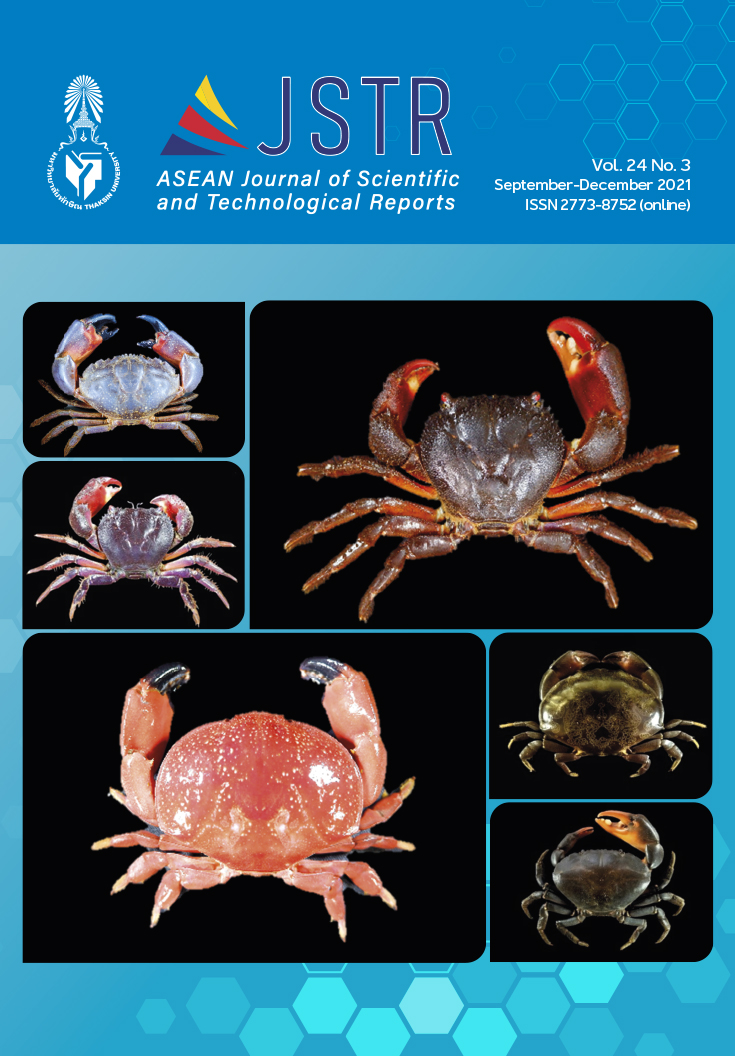Antioxidant properties of sacha inchi (Plukenetia volubilis) shell extracts as affected by solvents used for prior decolorization
Main Article Content
บทคัดย่อ
Sacha inchi (Plukenetia volubilis) shell is a potential source of phenolics with an-tioxidative activity and its extract can be used to prevent lipid oxidation in some food matrices. However, the sacha inchi extract has been fully exploited due to the dark brown colour properties associated with pigments. Thus, de-colourization of sacha inchi shells before extraction using solvents could be a means to bring about the extract with a lighter colour, which could be applied in foods without constraints. The effects of different solvents used for decolour-ization in sacha inchi (Plukenetia volubilis) shell powder on antioxidant proper-ties were investigated. The solvents used were methanol, acetone, chloroform and propanol. The ethanolic extracts' total phenolic content (TPC) and total flavonoid content (TFC) decreased when solvents were employed for prior de-colourization. Among all solvents, the ethanolic extracts from sacha inchi shell powder decolourized using chloroform (CHE) showed the highest TPC (9.94 mg GAE/g dry extract) and TFC (7.20 mg CE/g dry extract). Also, extracts from chloroform decolourized shell powder had the highest antioxidant activities (2,410.01, 111.60 and 4.58 µmol TE/g dry extract for 2,2-diphenyl-1-picrylhydrazyl (DPPH), 2,2-azino-bis(3-ethylbenzothiazoline-6-sulfonic acid) (ABTS) radical scaveng-ing activities, ferric reducing antioxidant power (FRAP), respectively, and 0.52 mmol EDTA /g dry extract for metal chelating assay) compared to other ex-tracts. Therefore, chloroform was the appropriate solvent for decolourization, and the resulting extract had higher antioxidant properties than others.
Article Details

อนุญาตภายใต้เงื่อนไข Creative Commons Attribution-NonCommercial-NoDerivatives 4.0 International License.
เอกสารอ้างอิง
D’Archivio, M.; Felesi, C.; Benedetto, R.D.; Gargiulo, R.; Giovannini, C.; Masella, R. Polyphenol, dietary sources and bioavailability. Annali dell’Istituto Superiore di Sanità. 2007, 43, 348–361.
Naczk, M.; Shahidi, F. Extraction and analysis of phenolics in food. Journal of Chromatography A. 2004, 1054, 95–111.
Benjakul, S.; Kittiphattanabawon, P.; Sumpavapol, P.; Maqsood, S. Antioxidant activities of lead (Leucaena leucocephala) seed as affected by extraction solvent, prior dechlorophyllisation and drying methods. Journal of Food Science and Technology. 2014, 51, 3026–3037.
Puupponen-Pimiä, R.; Nohynek, L.; Meier, C.; Ka€Hko€Nen, M.; Heinonen, M.; Hopia, A.; Oks-man-Caldentey, K.M. Antimicrobial properties of phenolic compounds from berries. Journal of Applied Mi-crobiology. 2001, 90, 494–507.
Benkeblia, N. Antimicrobial activity of essential oil extracts of various onions (Allium cepa) and garlic (Al-lium sativum). Journal of Food Science and Technology. 2004, 37, 263–268.
Heldt, H.W. Plant Biochemistry, 3rd ed.; Academic Press: Burlington, MA, 2004; 16, 399–408.
Cai, J.Q.; Liu, X.M.; Gao, Z.J.; Li, L.L.; Wang, H. Chlorophylls derivatives: Photophysical properties, assem-blies, nanostructures and biomedical applications. Mater. Today. 2021.
Roca, M.; Chen, K.; Pérez-Gálvez, A. Chlorophylls. In Handbook on natural pigments in food and beverages. Woodhead Publishing, 2016; 125–158.
Bohn, T.; Walczyk, T.; Leisibach, S.; Hurrell, R. Chlorophyll-bound magnesium in commonly consumed vegetables and fruits: Relevance to magnesium nutrition. Journal of Food Science. 2004, 69, 347–350.
Namal Senanayake, S. P. J. Green tea extract: Chemistry, antioxidant properties and food applications – A review. Journal of Functional Foods. 2013, 5, 1529–1541.
Olatunde, O.O.; Benjakul, S.; Vongkamjan, K. Antioxidant and antibacterial properties of guava leaf extracts as affected by solvents used for prior dechlorophyllization. Journal of Food Biochemistry. 2018, 42, 1–12.
Gutiérrez, R.M.P.; Mitchell, S.; Solis, R.V. Psidium guajava: a review of its traditional uses, phytochemistry and pharmacology. Journal of Ethnopharmacology. 2008, 117, 1–27.
Chirinos, R.; Pedreschi, R.; Domínguez, G.; Campos, D. Comparison of the physico-chemical and phyto-chemical characteristics of the oil of two Plukenetia species. Food Chemistry. 2015, 173, 1203–1206.
Wanyo, P.; Meeso, N.; Siriamompun, S. Effects of different treatments on the antioxidant properties and phenolic compounds of rice bran and rice husk. Food Chemistry. 2014, 157, 457–463.
Do Prado, A.C.P.; da Silva, H.S.; da Silveira, S.M. Effect of the extraction process on the phenolic compounds profile and the antioxidant and antimicrobial activity of extracts of pecan nut [Carya illinoinensis (Wangenh) C. Koch] shell. Industrial Crops and Products. 2014, 52, 552–561.
Chotphruethipong, L.; Benjakul, S.; Kijroongrojana, K. Optimization of extraction of antioxidative phenolic compounds from cashew (Anacardium occidentale L.) leaves using response surface methodology. Journal of Food Biochemistry. 2017, 41, 1–10.
Siomos, A.S.; Gerasopoulos, D.; Tsouvaltzis, P.; Koukounaras, A. Effects of heat treatment on atmospheric composition and color of peeled white asparagus in modified atmosphere packaging. Innovative Food Science and Emerging Technologies. 2010, 11, 118–122.
Yang, J.; Martinson, T.E.; Liu, R.H. Phytochemical profiles and antioxidant activities of wine grapes. Food Chemistry. 2009, 116, 332–339.
Wu, H.C.; Chen, H.M.; Shiau C.Y. Free amino acids and peptides as related to antioxidant properties in protein hydrolysates of mackerel (Scomber austriasicus). Food Research International. 2003, 36, 949–957.
Binsan, W.; Benjakul, S.; Visessanguan, W.; Roytrakul, S.; Tanaka, M.; Kishimura, H. Antioxidative activity of Mungoong, an extract paste, from the cephalothorax of white shrimp (Litopenaeus vannamei). Food Chemis-try. 2008, 106, 185-193.
Benzie, I.F.F.; Strain, J.J. The ferric reducing ability of plasma (FRAP) as a measure of "antioxidant power" The FRAP assay,” Analytical Biochemistry. 1996, 239, 70–76.
Boyer, R.F.; McCleary, C.J. Superoxide ion as a primary reductant in ascorbate-mediated ferretin iron re-lease. Free Radicals Biology & Medicine. 1987, 3, 389–395.
Steel, R.G.D.; Torrie, J.H. Principle and procedure of statistics; a biometrical approach, 2n ed; McGraw-Hill Koga-kusha, Ltd.: Tokyo, 1980, 1–633.
Khoddami, A.; Wilkes, M.A.; Roberts, T.H. Techniques for analysis of plant phenolic compounds. Molecules. 2013, 18, 2328–2375.
Złotek, U.; Mikulska, S.; Nagajek, M.; Świeca, M. The effect of different solvents and number of extraction steps on the polyphenol content and antioxidant capacity of basil leaves (Ocimum basilicum L.) extracts. Saudi Journal of Biological Sciences. 2016, 23, 628–633.
Rubalya Valantina, S.; Neelamegam, P. Selective ABTS and DPPH-radical scavenging activity of peroxide from vegetable oils. International Food Research Journal. 2015, 22, 289–294.
Seo, J.; Lee, S.; Elam, M.L.; Johnson, S.A.; Kang, J.; Arjmandi, B.H. Study to find the best extraction solvent for use with guava leaves (Psidium guajava L.) for high antioxidant efficacy. Food Science & Mitrition. 2014, 2, 174–180.


